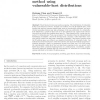468 search results - page 5 / 94 » Distributed Worm Simulation with a Realistic Internet Model |
INFOCOM
2003
IEEE
13 years 12 months ago
2003
IEEE
— It has been clear since 1988 that self-propagating code can quickly spread across a network by exploiting homogeneous security vulnerabilities. However, the last few years have...
WORM
2004
13 years 8 months ago
2004
A major challenge when attempting to analyze and model large-scale Internet phenomena such as the dynamics of global worm propagation is finding ate abstractions that allow us to ...
IJSN
2007
13 years 6 months ago
2007
: Most Internet worms use random scanning. The distribution of vulnerable hosts on the Internet, however, is highly non-uniform over the IP-address space. This implies that random ...
PADS
2005
ACM
14 years 7 days ago
2005
ACM
Most well-known Internet worms, such as Code Red, Slammer, and Blaster, infected vulnerable computers by scanning the entire Internet IPv4 space. In this paper, we present a new s...
CCS
2003
ACM
13 years 12 months ago
2003
ACM
After the Code Red incident in 2001 and the SQL Slammer in January 2003, it is clear that a simple self-propagating worm can quickly spread across the Internet, infects most vulne...

